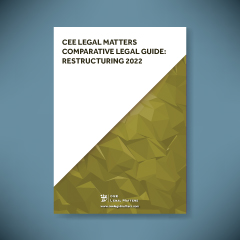Contributed by Jovovic, Mugosa & Vukovic.
1. Overview
1.1. What domestic pieces of legislation and international instruments apply to restructuring and insolvency matters in your jurisdiction?
In our jurisdiction, insolvency matters are subject to the Insolvency Act (Official Gazette of Montenegro 1/2011, 53/2016, 32/2018, Decision of the Constitutional Court of Montenegro, 62/2018, and Decision of the Constitutional Court of Montenegro, 1/2022), precisely to the insolvency through bankruptcy proceeding and restructuring.
Also, insolvency of the banks is regulated through special norms, precisely through provisions of the Banks’ Insolvency and Liquidation Act (Official Gazette of the Republic of Montenegro, 47/2001 and Official Gazette of Montenegro 62/2008, 44/2010, and 72/2019)
Additionally, the Insurance Companies’ Liquidation and Bankruptcy Act (Official Gazette of Montenegro 42/2015) regulates insolvency matters in insurance companies.
However, in this guide, we will deal with the Insolvency Act which applies to the insolvency of other companies and is most used in practice.
1.2. Do you have a well-established legal regime governing restructuring and insolvency, or do you have rather frequent legislative changes in the area?
We believe our legislation has a detailed and well-established insolvency proceeding, as well as passing, adopting, and implementing a restructuring plan. Recent amendments to the Insolvency Act entered into force on January 18, 2022, and they mainly refer to the provisions regarding the election of the administrator as a key figure in the implementation of the insolvency proceeding.
1.3. Are there any special regimes applying to specific sectors?
The existing Insolvency Act of Montenegro does not provide for any special regimes applying to specific sectors, however, it is not applied to banks.
1.4. Were any changes to restructuring or insolvency laws adopted in response to the COVID-19 pandemic? If so, what were they?
There were no changes in the Insolvency Act in response to the COVID019 pandemic.
1.5. Are there any proposed or upcoming changes to the restructuring insolvency regime in your country?
Currently, there are no indications of amendments, given that the most recent amendments entered into force beginning of this year. However, it always depends on the current needs of the economy and business sector.
1.6. Has your country adopted or is your country considering the adoption of the UNCITRAL Model Law on Enterprise Group Insolvency?
Our country has not yet adopted the UNCITRAL Model Law in the insolvency area, however, it is realistic to expect it to happen in the future.
2. Insolvency
2.1. Is there an insolvency test that triggers certain obligations for directors or officers of the debtor company? If so, what is the test and what are the consequences for failure to meet these obligations?
Our legal system does not provide for an “insolvency test,” however the Insolvency Act differentiates the reasons for bankruptcy, in terms of permanent incapability of payments or over-indebtedness.
2.2. What types of insolvency procedures are established by law in your jurisdiction?
As indicated above, insolvency, in terms of the Insolvency Act, shall be implemented through bankruptcy and restructuring.
2.3. Who has the right to initiate insolvency proceedings?
Insolvency proceedings may be initiated upon a proposal by the bankruptcy creditor, bankruptcy debtor, or liquidator.
2.4. What are the consequences of commencing insolvency proceedings, in particular:
2.4.1. Does management continue to operate the business and/or is the debtor subject to supervision?
The debtor is subject to supervision through an administrator assuming the rights and obligations of the debtor’s authority as a legal person, hence, when the debtor continues to operate, operations are managed by the administrator, meaning management does not continue to operate the business.
2.4.2. Does a moratorium or stay apply and if so, can it have an extraterritorial effect?
We shall indicate the different approaches in the two most recent Montenegrin pieces of legislation that regulate insolvency matters, primarily the Companies’ Insolvency Act which stopped being in force on the day the Insolvency Act entered into force.
The Companies’ Insolvency Act that formerly regulated the area provided that when requests for initiating insolvency proceedings are filed, it immediately triggers a temporary suspension of all the claims or activities aimed at settling the claims against debtors (moratorium), including:
(1) All actions aimed at settling or charging the debts, taxes, penalties, or other liabilities incurred before the date of request filing, except in the procedure of reporting the claims;
(2) All actions aimed at establishing, changing, or implementing the liens or securing the claims against the assets from the bankruptcy estate;
(3) All actions aimed at acquiring, confiscating, or selling any secured assets under lien out of the debtor’s bankruptcy estate or other actions taken over the assets from the bankruptcy estate. However, this piece of legislation is no longer in force.
On the other hand, under the current norms, all court and administrative procedures related to the bankruptcy debtor and their assets are stopped at the moment of the occurrence of legal consequences created by the initiation of the insolvency proceeding.
A lawsuit in which the bankruptcy debtor acts as the claimant shall be continued once the administrator informs the court competent for the particular lawsuit that the procedure was taken over. An administrative procedure initiated at the debtor’s request shall be continued once the administrator informs the authority that the procedure was taken over.
A lawsuit in which the debtor acts as the respondent shall be continued if:
1) The claimant, acting as bankruptcy and secured creditor filed a timely and proper request for a claim;
2) The administrator contested the request for claims at the examination hearing;
3) The claimant is, as the bankruptcy or secured creditor, referred, by virtue of the judge’s conclusion, to the continuation of a suspended lawsuit for the purpose of establishing the grounds for the claim;
4) The claimant, as the bankruptcy or secured creditor, suggested the continuation of the suspended procedure within eight days from the date of receipt of the conclusion made by the bankruptcy judge.
2.4.3. How does it impact the existing contracts (e.g., is the counter-party free to terminate them, can the debtor’s pre-insolvency transactions be challenged)?
Insolvency procedures can have various repercussions, depending on the type of pre-insolvency transactions carried out with the contracting party.
In bilateral contracts, if the debtor and the contracting party failed to meet their liabilities thereunder wholly or partially until the initiation of the insolvency proceeding, the administrator may meet the obligations under the contract instead of the bankruptcy debtor and require their fulfillment from the other party. If the administrator refuses the fulfillment of the obligations, a contracting party with the bankruptcy debtor may collect their claims in the capacity of a creditor. If the debtor’s co-contractor invites the administrator to give their position regarding the obligations under the contract, the administrator shall inform the debtor’s co-contractor in writing whether they intend to fulfill such obligations within 15 days from the date of receiving the invitation.
If the administrator says that the obligations arising from the contract will be met, and ceases to fulfill them in the course of the insolvency proceeding, claims under such a contract shall fall into the first payment line, as the expenditure of the insolvency proceeding.
In the case of financial leasing, the repercussion of insolvency proceedings over the leasing recipient-debtor shall be reflected in that the grantor of the leasing shall be entitled to a separate settlement and priority rights over the subject of the leasing. Depending on the manner the insolvency proceeding is terminated, the repercussions shall be the following:
In case of bankruptcy, the debtor, i.e., the administrator shall give the subject of the leasing to the leasing grantor, within 30 days from the receipt of the written request, that may be sent following the decision on the bankruptcy and sale of assets, except in case the leasing grantor agrees with a different decision or that the funds accrued through the sale are used to settle the obligation towards the leasing grantor, as the obligation of the bankruptcy estate.
In case of restructuring, the debtor, i.e., the administrator, shall inform the leasing grantor in writing of the intention to continue to use the assets subject to the leasing, within eight days from the date of receipt of the written request.
In terms of fixed contracts entered into in the pre-insolvency stage over one contracting party, aimed at performing fixed affairs, the law provides that if the time of fulfillment of obligations arising from the fixed contract follows the initiation of the insolvency proceeding, a contracting party of the debtor may not require the fulfillment of such obligations, but may request the compensation due to non-performance, in the capacity of the bankruptcy creditor.
In lease agreements, the lease shall not cease by the initiation of an insolvency proceeding.
In commission contracts, there is a differentiation between the two consequences of initiating the insolvency proceeding.
Insolvency Act provides that in case of the principal’s insolvency, the debtor’s contracting party, i.e., the seller or its commissioner, who has not been paid in full, may request the goods sent to the debtor and not delivered to the desired place until the date of initiating the insolvency proceeding to be returned (right to return).
The Obligation Relations Act provides that in case of a commissioner’s insolvency, the principal may require the exclusion from the bankruptcy estate which was given to the commissioner to sell at their account, as well as the things the commissioner supplied at their account.
The order shall cease to be valid ex lege once the principal or the agent undergo insolvency.
In case of bankruptcy of a policyholder, the insurance shall be continued, however, both parties are entitled to terminate the insurance agreement within three months of the initiation of the insolvency, in which case the policyholder’s bankruptcy estate implies a part of the paid premium corresponding to the remaining duration of insurance. In case of the insurer’s bankruptcy, the insurance contract shall terminate upon the expiry of 30 days following the initiation of bankruptcy.
The Insolvency Act acknowledges the contestation of the debtor’s legal activities, therefore it provides that legal affairs and other actions concluded, i.e., taken prior to the initiation of an insolvency proceeding, that impede evenly settlement of bankruptcy creditors or harm creditors, as well as legal affairs and other matters that favor certain creditors, may be contested by the administrator, on behalf of the debtor, or by creditors, in accordance with that law. Additionally, legal affairs, legal and procedural actions under which an enforcement decision has been passed or which were taken under the enforcement document or in the enforcement procedure, may also be contested if they meet the requirements referred to in that act. Should the contestation request be adopted, the legal effects of the enforcement decision in terms of the bankruptcy estate shall cease to be in force.
2.5. Which steps do insolvency proceedings normally include and what are the roles of the courts and other key stakeholders (such as debtor, directors of the debtor, shareholders of the debtor, secured creditors, unsecured creditors, etc.)?
Insolvency proceedings are implemented at the Commercial Court of Montenegro as a court with subject matter jurisdiction. It is initiated as per the proposals of the persons indicated in Section 2.3. Insolvency proceedings bodies include the bankruptcy judge, an administrator, and the creditors’ board. The court shall pass a decision on the initiation of the previous insolvency proceeding within three days from the submission of the proposal, therefore, for the sake of establishing the existence of reasons for initiating the insolvency proceeding. By rule, the previous insolvency proceedings shall last 30 days from the date of proposal submission, while the authorities for a temporary administrator shall be defined through a decision on its appointment and shall be valid until the adoption of the decision on initiating the insolvency proceeding. To that end, a bankruptcy judge shall schedule the hearing to discuss the existence of reasons to initiate the insolvency proceeding, which are supposed to be attended by the proposal petitioner, bankruptcy debtor, and the administrator appointed in the previous insolvency proceeding. Insolvency proceedings shall be led without the previous insolvency proceedings in the following circumstances: if a debtor files a petition for initiating insolvency proceedings if a creditor files a petition to initiate insolvency proceedings while the debtor acknowledges the existence of insolvency reasons when the proceedings are initiated at creditor’s proposal since the insolvency reasons were met, reflected in the fact that the creditor was not able to settle their claims in the enforcement procedure within 45 days as of the date when the enforcement began.
A judge shall decide regarding the petition for initiating insolvency proceedings.
Following this, creditors shall file a petition for their claims within 30 days from the date of publishing the ad regarding the initiation of insolvency proceedings in the Official Gazette of Montenegro.
Secured creditors shall file a petition for the claims in the same way as regular bankruptcy creditors. On the contrary, creditors with an exclusion right shall file a petition to have the matter not included in the bankruptcy estate excluded.
Upon the expiry of a deadline for filing the petitions for claims, a bankruptcy judge shall submit all the petitions for claims to the administrator to adopt the list of all acknowledged and contested claims at the previously scheduled examination hearing as a final one. The claim shall be deemed final if not contested by the administrator or bankruptcy creditors until the conclusion of the examination hearing. A final list defining claims and payment schedules shall be binding upon the debtors and creditors.
In case the bankruptcy debtor, following the initiation of an insolvency proceeding, fails to file a statement of intention to restructure the company or a restructuring plan has not been submitted within the deadline prescribed by law, or a submitted restructuring plan has not been adopted, or a debtor requests the court to adopt a decision on going bankrupt, the judge shall adopt a decision on going bankrupt. Following this decision, the assets are cashed in, therefore, the administrator publicly advertises and implements the sale of the debtor’s complete or partial assets. The administrator shall evaluate the purpose of the debtor’s sale as a legal entity, i.e., either the complete assets or in parts, and inform thereof the creditors’ board. The sale of assets is performed through a public bid, through the collection of bids, or through a direct bargain, in line with the act.
The judge shall pass a decision defining the final hearing.
The court may, finally, order a liquidation to be implemented in line with the Insolvency Act.
If the continuation of the debtor’s operations is economically justified, or if going bankrupt does not provide for a more favorable settlement of the creditors, the restructuring shall be implemented. A restructuring plan can be filed simultaneously with an insolvency proceedings petition or following the initiation of the insolvency proceedings, in line with the act.
The restructuring procedure is elaborated in Section 3.
2.6. In insolvency proceedings, do specific stakeholders’ claims enjoy priority (e.g., employees, pension liabilities)? Can the claims of any class of creditor be subordinated (e.g., equitable subordination)?
Payment schedules are divided into three categories:
1) The first payment schedule includes:
a. Claims under the gross salaries of employees and former employees in the amount of base remunerations achieved at the employer with interest accrued from the maturity date to the date of initiating the insolvency proceeding;
b. Employees’ claims for injuries at work with the debtor, prior to and after filing the petition to initiate the insolvency proceeding;
2) The second payment schedule includes claims under the contributions for pension and disability insurance of the employees and former employees that are not included in the first payment schedule;
3) The third payment schedule includes claims of other creditors.
Claims of creditors who agreed, prior to the initiation of the insolvency proceeding, to be settled only after full settlement of the claims of one or more creditors, shall be settled following the complete settlement of the third payment schedule with accrued interest.
2.7. What is a timeline for insolvency proceedings and how are they finalized?
One of the basic principles of insolvency proceedings is the principle of urgency, therefore a deadlock or termination of the proceedings is not allowed. However, the Insolvency Act does not provide for the final deadline or timeframe within which the proceeding has to be completed.
Insolvency proceedings last from the publishing in the Official Gazette of Montenegro until their completion.
Ways to terminate insolvency proceedings have been stated through the steps in insolvency proceedings in Section 2.5.
2.8. Are there any liabilities that survive the insolvency proceedings?
Definitely, yes. These imply bankruptcy estate liabilities. Namely, once insolvency proceedings are terminated, the company is stricken off the registry, however, if there is a dispute not terminated until the moment the insolvency proceedings are terminated, such a dispute remains the liability of a bankruptcy estate of a former debtor. An administrator is appointed as the representative of the bankruptcy estate and governs the proceedings until terminated.
3. Restructuring
3.1. What formal and informal restructuring proceedings are available in your country?
According to our legislation, there is only one type of restructuring in our jurisdiction, namely formal restructuring.
3.2. What are the entry requirements to restructuring and how are restructuring plans approved and implemented?
Restructuring, as one of the types of insolvency, shall be initiated through a petition for restructuring, that may be filed along with the proposal for insolvency initiation or following the initiation, within 60 days. Restructuring is implemented if it enables a more favorable settlement of creditors when compared to going bankrupt, and especially if there are economically-driven conditions for the debtor’s continuation of operations. At the hearing envisaged for consideration of the restructuring plan and creditors’ voting, the judge shall pass a decision either confirming the adoption of such a plan or dismissing it. The decision confirming the adoption of the restructuring plan shall be published at the information board in court and in the Official Gazette of Montenegro.
3.3. Who has the right to initiate formal restructuring proceedings?
A restructuring plan may be submitted by a debtor, administrator, the secured creditor having at least 30% secured claims in comparison to the total claims towards the debtor, creditors having at least 30% unsecured claim in comparison to the total claims towards the debtors, as well as persons being the owners of at least 30% of debtor’s capital.
3.4. What are the consequences of commencing restructuring proceedings, in particular:
Once the restructuring plan has been adopted, all claims and rights of creditors and other persons, as well as the obligations of the debtor referred to in the restructuring plan are exclusively subject to the requirements in the restructuring plan. Creditors, whose claims occurred prior to the adoption of the restructuring plan but have not been covered therein, and who have not filed a petition regarding their claims in the insolvency proceeding, may not settle their claims through forced execution during the implementation of the restructuring plan. The adoption of the decision on restructuring terminates all the consequences of initiating the insolvency proceeding, and the label “under the insolvency proceeding” shall be deleted from the name of the debtor, while when this decision becomes final, the insolvency proceeding is terminated completely. By virtue of a court decision, the adopted restructuring plan is an enforceable document and shall be deemed a new contract for the settlement of claims contained therein. Affairs and activities taken by the debtor must be in accordance with the adopted restructuring plan.
3.4.1. Does management continue to operate the business and/or whether the debtor is subject to supervision?
Management shall continue managing the company on their own, however, they are completely bound to comply with the restructuring plan, given that if not, it shall be terminated and the debtor goes bankrupt.
3.4.2. Does a moratorium or stay apply, and, if so, what is its scope?
Given that all the consequences of the insolvency are terminated by the adoption of the restructuring plan, it implies that all the procedures existing prior to the initiation of the insolvency are continued as well as the company’s operations in line with the restructuring plan.
3.4.3. How do restructuring proceedings affect existing contracts?
3.4.4. How are existing contracts treated in restructuring and insolvency processes?
Part of the answer to these two questions is contained in Section 2.4.3. However, concerning the claims arising prior to the initiation of insolvency proceedings, to be settled they must be reported in the insolvency proceedings, and in the case of adoption of a restructuring plan, they must be envisaged within it.
Therefore, once a restructuring plan has been adopted, all claims and rights of creditors and other persons, as well as the obligations of the debtor, referred to in the restructuring plan, are exclusively subject to the requirements in the restructuring plan. Creditors, whose claims occurred prior to the adoption of the restructuring plan but have not been covered therein, and who have not filed a petition regarding their claims in the insolvency proceeding, may not settle their claims through forced execution during the implementation of the restructuring plan.
3.5. Can third-party liabilities be released through restructuring proceedings?
Third parties may release the debtor of their obligations through the principle of debt acquittance, if that is what has been implied by this question.
If this implies the debt acquittance of the debt that third parties have against the debtor, we are not sure that this principle may be applied, given that the debtor has liabilities against their creditors, therefore applying this principle may hamper the collection of their claims.
3.6. Which steps do restructuring proceedings normally include and what are the roles of the courts and other key stakeholders (such as debtor, directors of the debtor, shareholders of the debtor, secured creditors, unsecured creditors, etc.)?
For a restructuring plan to be considered at all, it should be filed in the first place. A bankruptcy judge is the one having the key role in this phase, since they hold a hearing to consider the restructuring plan, followed by voting, with all the creditors having the right to vote in proportion to the amount of their claims. The restructuring plan shall be deemed adopted in one class of creditors if the restructuring plan has been voted for by the creditors having simply the majority of claims in comparison to total claims by creditors in such a class. At the hearing envisaged for consideration of the restructuring plan and creditors’ voting, the judge shall pass a decision either confirming the adoption of such a plan or dismissing it. Finally, through execution of the restructuring plan by which the debtor fulfilled all the obligations envisaged therein, creditors’ claims are terminated.
Other persons may, as stated in Section 3.3., submit the restructuring plan and depending on that take their position in the procedure.
3.7. How are restructuring proceedings normally finalized?
Through the execution of the restructuring plan by which the debtor fulfilled all the obligations envisaged therein, creditors’ claims are terminated, hence the restructuring proceeding is finalized. However, if the restructuring plan is not complied with, such a proceeding is terminated, and the company goes bankrupt.
4. Cross-border restructuring and insolvency
4.1. Do domestic courts in your country recognize foreign insolvency or restructuring proceedings over a local debtor?
The commercial court is the first instance court in recognition and execution of foreign court decisions adopted by commercial courts as well as foreign arbitration decisions. The Insolvency Act provides for the reasons to apply provisions related to international insolvency, hence it provides that insolvency proceedings are subject to the governing law of the country in which the proceedings are initiated, unless otherwise defined by this law. On the contrary, in case of recognition of foreign proceedings in line with this law, the secured rights and right to exclusion over matters or rights located on the territory of Montenegro, Montenegrin regulations shall apply. Upon the initiation of the insolvency proceeding over the debtor whose registered seat is in Montenegro, i.e., whose main place of interest is in Montenegro, foreign proceedings may only be recognized as secondary foreign proceedings.
4.2. What are the preconditions for recognizing foreign decisions?
A foreign representative is entitled to direct actions before Montenegrin courts. In case of filing the request for recognition, for the purpose of proving their capacity, the representative shall file the following: A decision on initiating the foreign proceeding and appointment of a foreign representative in original form or certified copy, translated into the language in official use at the competent court in Montenegro, along with evidence of its enforceability according to the law of a foreign country; a certificate of a foreign court or other competent body proving the existence of foreign proceedings and appointment of a foreign representative; other evidence proving the existence of foreign proceedings and appointment of a foreign representative which the competent court in Montenegro deems acceptable, in the absence of previously mentioned evidence. The foreign representative may file a request with the competent Montenegrin court regarding the recognition of foreign proceedings in which it has been appointed if legally required capacities are previously proven. Along with the request for recognition, a statement given by the foreign representative is also filed, indicating all foreign proceedings related to the debtor and familiar to the foreign representative, translated into the language in official use at the competent court in Montenegro.
Sections 4.1. and 4.2. refer to recognition of a foreign decision on initiating the insolvency, given that the Montenegrin Insolvency Act provides for such type of recognition, all aiming at avoiding parallel insolvency proceedings, to secure the rights of both debtors and creditors, hence in such a case a distinction is made between the main and the secondary insolvency proceeding (4.1.)
4.3. Do domestic courts cooperate with their counterparts in other jurisdictions and if so, what does such recognition depend on (such as the COMI of the debtor, the governing law of the debt to be compromised, etc.)?
At the request of a foreign representative and from the moment of filing the request for recognition of foreign proceedings up until the decision-making regarding such a request, the court may provide necessary legal assistance of a temporary nature in case such assistance is urgently needed to protect debtor’s assets or creditors’ interests. Following the recognition of foreign proceedings, either as the main or secondary ones, and if necessary in order to protect the debtor’s assets or creditors’ interests, the court may, at the request of a foreign representative, provide suitable assistance through establishing the following measures: 1) the prohibition to initiate new ones, or termination of initiated proceedings in relation to assets, rights, obligations, or liabilities of the debtor; the prohibition of enforcement over the debtor’s assets if enforcement has not been terminated; the prohibition to transfer, encumber, or otherwise dispose of the debtor’s assets; implementing evidence through hearing the witnesses or otherwise, as well as providing information related to the assets, operations, rights, obligations, or liabilities of debtors; entrusting to the foreign representative or other person appointed by the court to manage or sell the debtor’s assets or part of assets located in Montenegro; prolonging the validity of security measures; providing other authorities vested in the administrator under the law or establishing other prohibitions in accordance with law.
Following the recognition of foreign proceedings, either as the main or secondary ones, the court may, at the request of the foreign representative, entrust the division of debtor’s assets or part of assets located in Montenegro to a foreign representative or other person defined by the court, provided that the court establishes that proper protection of creditors’ interests in Montenegro has been accounted for.
When providing assistance to a foreign representative in case of secondary foreign proceedings, according to this article, a court shall establish that such assistance refers to assets which, in accordance with this law, are supposed to be managed within such a secondary foreign proceeding or it refers to information necessary in such a proceeding.
The law sets forth that the court is obliged to cooperate to the full extent with foreign courts and other competent authorities or foreign representatives, either directly or through an administrator.
The court is entitled to directly address, i.e., to directly require information or assistance from foreign courts and other competent authorities or from foreign representatives.
4.4. How are foreign creditors treated in restructuring and insolvency proceedings in your jurisdiction?
Except for the cases of secured rights and rights to exclusion, a creditor whose claim has been partially settled in the proceeding conducted in accordance with the law regulating insolvency matters, cannot receive, in a foreign country, a payment accounting for the same claim in the insolvency proceeding conducted against the same debtor, all until the payments against other creditors of the same payment schedule or class in restructuring are proportionally lower than the amount already received by such creditor.
5. Summary
5.1. Overall, do you have a more creditor-friendly or debtor-friendly restructuring and insolvency regime in your jurisdiction?
Through the interpretation of the very notion of insolvency proceedings, it might be said that the regime favors neither the debtor nor the creditors, but it is initiated to the benefit of both.
Insolvency is a legally-regulated procedure implemented over the legal entities – debtors who face serious impediments in their operations, while the main goal of insolvency is to enable the most favorable collective settlement of those having some claims against it – creditors, by selling the legal entity’s assets to settle those claims. Additionally, when implementing a restructuring plan, there are positive effects both on debtors and creditors, given that creditors are those who decide on the adoption of the restructuring plan, by giving their vote aiming at fulfilling their personal needs, while, on the other hand, a debtor is given a chance for a new beginning.







